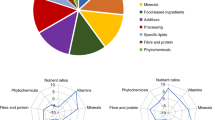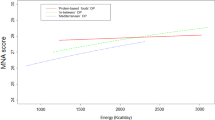Abstract
Background/Objectives:
‘NutPlan’ is developed within the EURRECA Network of Excellence (EURopean micronutrient RECommendations Aligned (http://www.eurreca.org). It is a user-friendly software programme with multiple functions: individual and group nutrition planning, recipe calculation, creating food labels, diet planning and nutrient intake assessment. This paper describes the newly developed software and its features.
Subjects/Methods:
‘NutPlan’ contains the following databases: foods, dish recipes, meals, menus, average menus and glossary. These databases enable diet planning and diet analysis by comparing foods, dishes, meals or menus with currently available nutritional recommendations accessible by a link to EURRECA tool Nutri-RecQuest to meet individual/group nutritional needs.
The software is upgraded by inserting new items (for example, foods, dishes, meals) and for a connection to other software programmes, thus allowing more advanced calculations to be completed.
Conclusion:
‘NutPlan’ might be the software of choice for individual and group diet planning. It is aimed particularly at Eastern European and West Balkan countries, which currently lack dietary software. It is envisaged for use by small and medium enterprises in the food industry, as well as by health professionals, researchers and policy makers, and can be recommended for educational purposes. Given its characteristics of being upgraded to include new country-specific food data/database, it can be recognized as an important tool in nutritional capacity development in the Central Eastern European and other regions.
This is a preview of subscription content, access via your institution
Access options
Subscribe to this journal
Receive 12 print issues and online access
$259.00 per year
only $21.58 per issue
Buy this article
- Purchase on Springer Link
- Instant access to full article PDF
Prices may be subject to local taxes which are calculated during checkout


Similar content being viewed by others
References
Bognár A (2002). Tables on weight yield of food and retention factors of food constituents for the calculation of nutrient composition of cooked foods (dishes) Bundesforschungsanstalt für Ernährung, Karlsruhe.
Cavelaars AEJM, Kadvan A, Doets EL, Tepšić J, Novaković R, Dhonukshe-Rutten R et al. (2010). Nutri-RecQuest: a web-based search engine on current micronutrient recommendations. Eur J Clin Nutr 64(Suppl 2): S43–S47
Eckstein EF. (1967). Menu planning by computer: the random approach. J Am Diet Assoc 51, 529–533.
European Commission (2008). Proposal for a Regulation of the European Parliament and of the Council on the Provision of Food Information to Consumers. European Commission: Brussels.
European Food Information Resource Network (EuroFIR). http://www.eurofir.net (accessed 11 January 2010).
European Micronutrient Recommendations Aligned (EURRECA). http://www.eurreca.org (accessed 11 January 2010).
European Micronutrient Recommendations Aligned Wiki (EURRECA Wiki). http://www.eurrecawiki.org (accessed 11 January 2010).
Gurinovic M, Kadvan A (2007). ‘Nutrition plan’-NUTPLAN, Software for planning individual and collective nutrition with nutrition recommendations, 1996 and new versions in 2005, 2007 (Copyright No. 426, A-171/02 CIP 613.2.001.681.31 and ISBN 86-901825-1-9).
Nutrition Software Review. http://nutrition-software-review.toptenreviews.com/ (accessed 7 January 2010).
Pavlovic M, Pepping F, Michal D, Biro L, Szabolcs P, Dimitrovska Z et al. (2009). Turning Dilemmas into opportunities: a UNU/SCN Capacity Development Network in Public Nutrition in Central and Eastern Europe. Public Health Nutr 12, 1046–1051.
Second WHO European Action Plan for Food and Nutrition Policy (2007–2012). Copenhagen, WHO Regional Office for Europe, 2007 (EUR/RC57/10. http://www.euro.who.int/Document/E91153.pdf, accessed 6 November 2009).
United Nations University/UN System Standing Committee on Nutrition, Network for Capacity Development in Nutrition in Central and Eastern Europe (NCDN-CEE). http://www.srbnutrition.info/?page=Network and http://typo3.gak.hu/index.php?id=76 (accessed 11 January 2010).
Acknowledgements
The studies reported herein are carried out by the EURRECA Network of Excellence, financially supported by the Commission of the European Communities, specific Research, Technology and Development (RTD) Programme Quality of Life and Management of Living Resources, within the Sixth Framework Programme, contract no. 036196. This report does not necessarily reflect the Commission's views or its future policy in this area. We acknowledge Lisette de Groot, Pieter van ’t Veer, Adriënne EJM Cavelaars, Esmée L Doets and Rosalie Dhonukshe-Rutten for their contribution to the link between Nutri-RecQuest and Nutrition software.
Author information
Authors and Affiliations
Corresponding author
Ethics declarations
Competing interests
L Bucchini has received consulting fees and has equity/stock ownership in Hylobates Consulting, has received grant support from EURRECA and an EC funded grant. He has also consulted for small/medium companies in the food supplement sector. The remaining authors have declared no financial interests.
Rights and permissions
About this article
Cite this article
Gurinović, M., Kadvan, A., Bucchini, L. et al. EURRECA nutritional planning and dietary assessment software tool: NutPlan. Eur J Clin Nutr 64 (Suppl 2), S38–S42 (2010). https://doi.org/10.1038/ejcn.2010.59
Published:
Issue Date:
DOI: https://doi.org/10.1038/ejcn.2010.59
Keywords
This article is cited by
-
Nutri-RecQuest: a web-based search engine on current micronutrient recommendations
European Journal of Clinical Nutrition (2010)
-
EURRECA: development of tools to improve the alignment of micronutrient recommendations
European Journal of Clinical Nutrition (2010)



